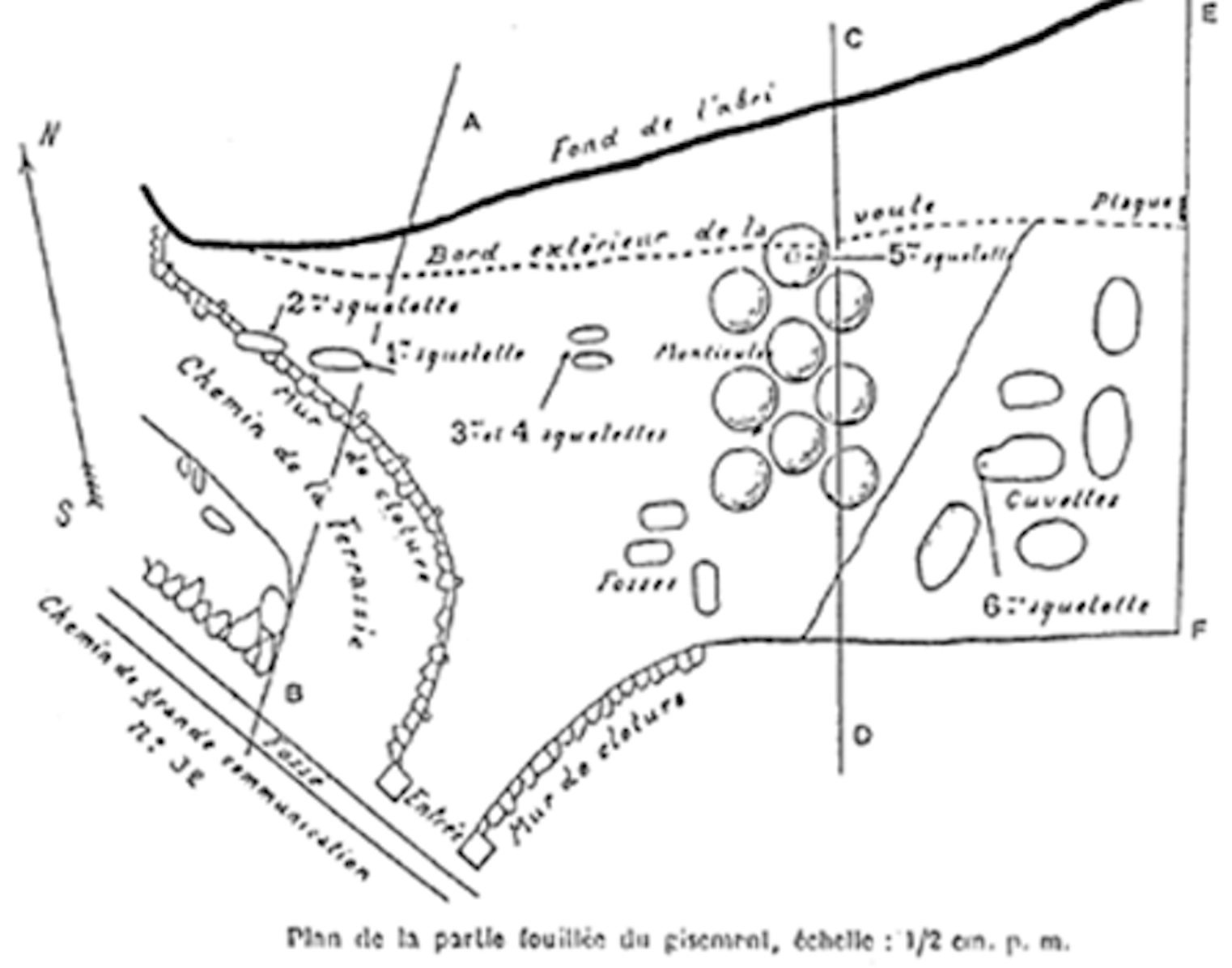
See also: Chukchi directions of Time and Space.
First excavated just before the First World War, it was clear that this was a significant Neanderthal ritual site. Under the shelter of a cliff overhang several burials were found, carefully laid out. On one side are the separate burials of different animals - and one decapitated child (were these sacrifices?). On the other side were human graves of men, women and children. Between them were many tiny graves of little babies.
All the graves of the people, adults and older children had been orientated from east to west.
Those where enough survived were found to have been buries to little carved figures, and food. The whole site indicates that the people in this region had well developed beliefs about their cosmos - ancestral to those still held by many today. The orientation of the graves and the possessions buried with the body, indicated that the deceased were believed to travel to another world.
Here is a copy of an original plan of the La Ferrasie site, the cliff face is at the top and the graves then excavated are shown.
Directions of time and space, according to the position of the sun
Concept of directions of time, space, and relationships to position of sun.
Evidence exists that by 70,000 years ago Neanderthal people had a concept of navigational direction.This can be seen in the deliberate orientation of Neanderthal/Mousterian ritual and burial sites. An example of this is the Neanderthal-Mousterian site at La Ferrassie in the Dordogne region of France, which has now been dated to about 70,000 years ago.

These early navigators were already accustomed to sailing between islands - some Indonesian islands have been inhabited by human ancestors for a million years, and the earliest early human (Java man) finds on Java date to two million years ago.
Even when the crossing was narrow enough to see the other side before you started out, there were strong currents, sharks, and crocodiles 9 metres long, not to mention toxic jellyfish. These early humans, who are generally called "homo erectus", would never have made it without sea-worthy boats.
An incentive to go further by sea may have been the volcanos of Indonesia. If the mountain behind your village is exploding in fire and raining rocks and boiling mud, you would make for the shore and boats and go. It can be no coincidence that there was a surge of human population in Australia, about 65,000 years ago, when there was a massive explosion of Mount Toba. The plume of dust and ash was blown north, causing mass extinction and devatation in what is now India and much of Asia and massive climate change triggering an ice age as the sun was blotted out by the dust for some years. The extinction at this time of larger, tastier animals like the giant kangaroo and giant wombat, could have been due to climate change but it seems was also due to the sudden rise in population of hungry humans.
Some traditional methods of navigation, then, may have been in use for many thousands of years. Navigation requires skilled knowledge, which has to be taught, it can not just be learned only by personal experience. When you went to sea, you had to know how to find out where you were, or you might not survive.
Navigators learnt how to find indications of their position and direction from the position of the sun, from the direction of the winds, from the shape and direction of waves, from the changing colours of the sea and the currents seen below the surface, and even the taste of the water, fresh or salty, and seaweed and sea creatures, from the appearance of clouds, from the behaviour of birds which return to land to roost on cliffs at night. And at night, the position of certain bright stars.
The direction of the rising sun, the east, was associated with life and good things. Our word "orientation" is derived from a word meaning "east". This, being the most auspicious, associated with light and life was the preferred direction. The "front". The East was the "front". Buildings - especially homes, often were made to face this way or to the southeast or south towards the dawn or rising or risen sun. Conversely, the direction of the setting sun and the dark north were associated with bad things and death.
The Neolithic long farm houses of Central Europe were all aligned in a NW to SE direction with the entrance at the SE end. In France the orientation was West to East with the front door to the east. In Poland the front entrance was to the south.
European bronze age dwellings were often round, like those of eastern England, and those still in use today, in North East Siberia, Eastern Siberia and the yurts of Central Asia. The Mongolian yurts had their doors to the south. The Chukchee yuranga always had its front entrance to the North East. The half-underground houses of the Bering Straits all faced the same way - to the east.
Much further south in Asia, in India and on the Tropic of Cancer, there are numerous indications to suggest that the Harappans, one of the world's earliest civilizations were well-versed in astronomy. The straight streets of their towns were oriented in the cardinal directions - east, west, north and south. Linkages between ancient Harappan scripts and latter Vedic texts also suggest that Harappan priest-astronomers tracked the progress of various planets and mapped the sky.
Symbolic orientation was obvious in the plan of the Iron Age Slav town of Biskupin in Poland. Within the surrounding wall, and bearing no relationship toit,or its gates, were rows of small terraced houses, aligned so that all front doors faced the South-East. Each terraced house had a hearth and its front door facing the narrow log paved street. This orientation must have been entirely motivated by religious symbolism for it had no convenience and the only place where people could gather, hold a market or a festival, and where a cart could turn round, was by the gate in the town wall.
In America, the log houses of the Navaho were also orientated according to their cosmological beliefs in the directions of the universe. The front doors faced east and the circular floor plan was symbolic of the sun and the universe.
The directions of time and space used in Central America by the Maya were associated not only with the time and the direction of the sun but other concepts. Gods, colours and other qualities. Much like the Chukchi Directions. But the Chukchi lived above the Arctic Circle, where the sun is either just above or just below the horizon. The Maya not much above the equator and saw the sun pass nearly overhead each day. The concepts of time and position are different to people living near the Equator to those in the far North. For the May, East and West were linked to sunrise and sunset, but north was the third side of the sky and south the fourth side.
In Japan the symbolism of the directions is shown in the Sumo ring. A roof is suspended over the ring with tassels at each corner is symblic colours. On the east and north corner, green tassels represent spring and the green dragon god of the east. Red tassels on the east and south corners represent summer and the red sparrow god of the south. At the southwest corner a white tassel symbolizes autumn and the white tiger god of the west. A black tassel on the north-west corner represents winter and the snake-encircled turtle god of the north and of water.
The Saxons said their prayers facing the East, to the God of the Risen Sun - World-Surveyor Man. As in the part of a Saxon prayer or charm translated into modern English: The instructions begin- Turn to the east and bowing humbly nine times say then these words: "Eastwards, I stand, for favours I pray, I pray the Great Lord, I pray the Might Prince, I pray the Holy Warden of the Heavenly Kingdom, To Earth I pray and up to Heaven."
Such customs survived in those parts of Europe where Christianity was imposed late. For example, the Mari farmhouse (east Russia) faced east and prayers were said each morning to the rising sun.
Christian churches - which according to policy were built if possible on existing religious sites (as at Stragglethorpe in Lincolnshire) are all orientated exactly to the compass, so people enter facing the east towards the altar and often a round stained glass sun window. At the west end you may find a window or painting of doomsday - the end of the world. The orientation and purpose would have been recognised instantly by the French Neanderthals 70,000 years ago.
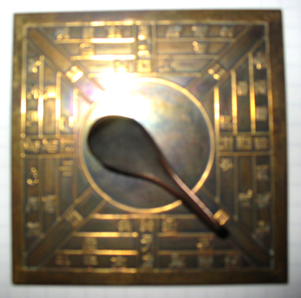 Originally intended for divination, the first compass was a development from the spoon-shaped (like the Plough constellation) shaman's baton used to hit the drum which could be placed on top and spun for fortune telling. This led to the fortune telling and feng shui device where the spoon - made of lodestone which is magnetic was spun in the centre of a marked square representing the square earth. (Its symbolic shape).
The handle of the spoon pointed south as it does in the photo. The meanings of the directions were all marked out. Modern versions of the feng shui compasses are still made and used today to orientate new buildings and so on as they were used in the past.
Originally intended for divination, the first compass was a development from the spoon-shaped (like the Plough constellation) shaman's baton used to hit the drum which could be placed on top and spun for fortune telling. This led to the fortune telling and feng shui device where the spoon - made of lodestone which is magnetic was spun in the centre of a marked square representing the square earth. (Its symbolic shape).
The handle of the spoon pointed south as it does in the photo. The meanings of the directions were all marked out. Modern versions of the feng shui compasses are still made and used today to orientate new buildings and so on as they were used in the past.
The main directions and qualities were:
The "south-pointer" was soon adapted to use for navigation. It was also used for time-keeping. By observing the moon's position at night,from the time of the moon's southing, the tides could be calculated.
The disadvantages of using a compass for the time when at sea were recognised in the 16th century, as John Davis writes in his book "The Seamans Secrets" in 1595: "But this accompt is very absurd, for with us in England (at midsummer) it is somewhat past 7 of the clock, at an East Sunne, and at a Southwest Sunne, it is past 10 of the clock, therefore the distinctions of time may not well be given by the compasse, unless the Sunne be upon the Meridian, or that you be farre toward the North"
| The Sakha had plenty of logs from the dense taiga forest to build their balagan, which was then plastered all over, roof too, with clay and cowpats. | 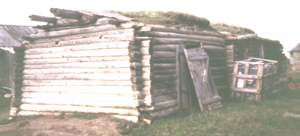 |
On the south side is the living quarters for people, on the north side for animals. The front door always faces the east. The small windows were glazed with ice in winter, and horse hair mesh or fishskin in summer.
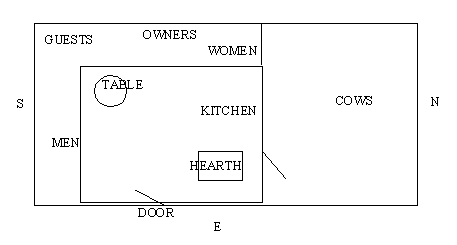 | Inside, bunks are built into the south and west sides to use as seating by day and beds by night, with curtains and fur rugs. The south-west corner is the "best" corner, where guests were received and accomodated. Next to this, facing the front door on the west side was the accommodation of the owners of the house. On the north side was the women's quarters - sometimes there was a separate room for girls and women. Also on the north side was the kitchen and a door to the barn part of the house.The clay chimney with hearth which served for cooking and heating was near the centre. |
In the best corner was a carved wooden table, with legs shaped like horses hooves. Some of these tables are very finely worked with inlays of different woods in patterns.
The whole country - Yakutia- now the Sakha Republic, but still part of the Russian Federation, was seen as aligned according to Sakha religous concepts. It was seen as a square or rather diamond shape with four corners.
The Yakut sagas - the olongkho - start with a feeling of endless space and time. From the ancient times there were three tribes of Gods:
The Upper World - Heaven, was created first, then the Lower World, then Earth in the middle. The Earth was round and surrounded by water. We live on Middle Earth. Above us is the Upper World - Heaven, below us, the Lower World.
The Upper World has nine levels - and all have their own different colours and properties.
The lower levels, near the earth, are blue. They have a blue sky and a constant wind. They are eternal dust and ice. Further up the middle sky is yellow and much brighter. The levels of heaven get lighter and lighter the higher they are above Earth, until the highest level is white. White is symbolic of the Upper Gods especially. The Sun is white - hence the national flag shows a white sun on a blue sky.
Each level of heaven has its own population of spirits and gods.
The first two layers are inhabited by evil spirits who send miseries like depression and criminal behaviour. For example when Blood God enters a man he makes him a murderer. Another of these gods makes people commit suicide. Suicides were buried without a coffin in a remote place because they had been possessed by an evil spirit. Another evil goddess turned women into prostitutes.
The higher levels of the sky were inhabited by nicer gods in a more pleasant environment. Each god was a protector of someone or something on middle Earth. There is a God of Tragic Fate, and a God of Good Fortune for example, as well as gods and goddesses for ordinary things on earth like cattle. Our children answer for us.
There are eight layers in the Lower World. Odd numbers are male, and have positive qualities. Even numbers are female and have negative qualities. So three is the number of Happiness, male etc etc. but eight is a negative sort of number and female. The ideal family wished for by a married couple was nine boys and eight girls.
As you go down in the underworld, below middle Earth, each level becomes darker and darker. The lowest world is a deep red colour. It is the bleeding layer of fire - which you can see each morning and evening at dawn and sunset. Lurking in the Lower World are the gods and spirits for each disease. A recent arrival in these regions were the deities for venereal diseases. These were apparently unknown in North East Siberia until the Russians arrived in the 17th century.
Middle Earth - where we live, is unprotected. It is crossed by a black whirling tunnel like an ox throat and sucks eternal emptiness into itself. Into this tunnel shamans go and become unbeing. I experienced this effect during a miscarriage long before I knew anything about shamanism: it felt like I was falling down a rabbit hole like Alice or a well with whirling sides and the spot of light getting smaller as I "fell". The spinning dance of the black shaman would make the shaman feel faint - the brain becomes short of oxygen, and that is what causes this hallucination and why it is so similar in many different cultures.
Unbeing for the shaman, is not death but a different state of being. But no one wanted to live in the middle world because of the black tunnel. So the Creators made someone to live there - ourselves.
Each person is made of good and kind things and evil things. The first people on middle Earth were alert and keen. The more they developed, the more they were driven from nature. And only the shaman can understand the mystery of nature and enter the entire world.
Every deity wanted to influence man, so man became the centre of the universe. If we do something in the wrong way we offend the spirits and they will not help us. So we have set rituals.
The Upper World is associated with men's creation, and horses. The Lower World is associated with women's creation and cows. In the Lower World the grass and trees are all made of iron. Everything is the opposite of the Upper World. Here in the middle world we have both men and women, both horses and cows.
The whole universe is connected by the World Tree. Its roots are in the Lower World, its branches are in the Upper World. The World Tree unites all three worlds. The symbolic World Tree - survives as the Christmas Tree.
There are four main Directions on Earth.
The East is where the sun rises, and the day begins.
The West is where the sun sets, and the evening begins. The shaman faces South and East to make kind blessings. Otherwise he faces West and North. Spring begins in the East (The English word for East and Easter have the same origins in the Saxon name for the goddess of spring and dawn). See Easter website.
There are eight Directions altogether. As well as north, south, east and west, there is northwest, northeast, southwest and southeast.
The Summer festival began with the sunrise and with kumiss. Shamans and women could not be present.
The autumn holiday represented the borderline between summer and winter seasons. It is held at night in September. This holiday was organized by the shamans. They gave a blood sacrifice. The symbol of winter was the North direction and the OX. First one horn of the ox falls down then the second horn, then the whole head, then spring comes. The South has positive attributes and is attractive but the north has negative attributes and is frightening. East and west are neutral.
One way of telling the time of day was to use the features on the horizon as a clock. Marking the hours as seen from a particular view point.
Not everyone has the resources of a clear wide and varied horizon, neither does everyone remain living in the same district all the year. The Evenk lived in the dense taiga forests of Siberia. In winter the tops of the trees stick out of the snow, in summer, the silver birch, larch and cedar rise out of a carpet of flowers covering miles of now-capped mountian ranges threaded by vast rivers, rushing streams and thousands of lakes. Traditionally the Evenk were nomadic reindeer herders and hunters, living even in the winters, in teepees made from wooden poles which were covered by reindeer skins in winter, and birchbark in summer. Reindeer are very demanding on pasture and the herds must be constantly on the move, seldom remaining in one place for more than a few weeks, sometimes only a few days. In the search for new pastures for their reindeer, ancestors of the Evenk, riding on reindeeer back, spread during the middle ages from their homelands in Manchuria and around Lake Baikal, north over Siberia from the Yenisey to the Pacific Ocean.
In the Taiga, their is no clear view of the sky and the horizon. to navigate themselves on their travels, the Evenks used ground features, such as the sunny or shady side of trees, the flow and appearance of rivers.
The Evenks used to be able to tell the time of day by measuring the direction and time of day by measuring the direction and length of the shadows. They divided the day into several "hours" and were said to be able to judge the time of day very accurately using this method. They also used other methods by which they were able to tell the time on cloudy days and when it was dark, but these have all been forgotten and I have found it difficult to find anyone with any information about this.
The two natural divisions of the day, the Evenks called day (inan) and night (dolbon), but the day was also divided into two other halves: From midnight (dolbondulin) to midday (inandulin) and from midday to midnight. There appears to have been about twenty small divisions of the day.
A few of these unequal "hours" were recorded in Manchuria (Northern China):
See also
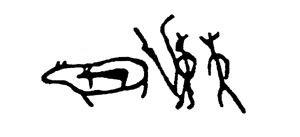 |